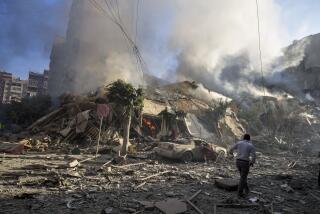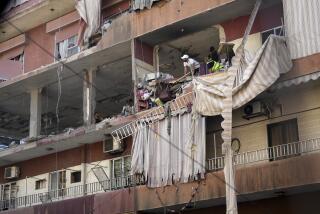Could this be the start of WWIII?
IT WAS LATE JUNE in Sarajevo when Gavrilo Princip shot Archduke Franz Ferdinand and his wife. After emptying his revolver, the young Serb nationalist jumped into the shallow river that runs through the city and was quickly seized. But the events he set in motion could not be so easily restrained. Two months later, Europe was at war.
The understanding that small but violent acts can spark global conflagration is etched into the worldâs consciousness. The reverberations from Principâs shots in the summer of 1914 ultimately took the lives of more than 10 million people, shattered four empires and dragged more than two dozen countries into war.
This hot summer, as the world watches the violence in the Middle East, the awareness of peaceâs fragility is particularly acute. The bloodshed in Lebanon appears to be part of a broader upsurge in unrest. Iraq is suffering through one of its bloodiest months since the U.S.-led invasion in 2003. Taliban militants are burning schools and attacking villages in southern Afghanistan as the United States and NATO struggle to defend that countryâs fragile government. Nuclear-armed India is still cleaning up the wreckage from a large terrorist attack in which it suspects militants from rival Pakistan. The world is awash in weapons, North Korea and Iran are developing nuclear capabilities, and long-range missile technology is spreading like a virus.
Some see the start of a global conflict. âWeâre in the early stages of what I would describe as the Third World War,â former House Speaker Newt Gingrich said last week. Certain religious websites are abuzz with talk of Armageddon. There may be as much hyperbole as prophecy in the forecasts for world war. But itâs not hard to conjure ways that todayâs hot spots could ignite.
Consider the following scenarios:
* Targeting Iran: As Israeli troops seek out and destroy Hezbollah forces in southern Lebanon, intelligence officials spot a shipment of longer-range Iranian missiles heading for Lebanon. The Israeli government decides to strike the convoy and Iranian nuclear facilities simultaneously. After Iran has recovered from the shock, Revolutionary Guards surging across the border into Iraq, bent on striking Israelâs American allies. Governments in Syria, Jordan, Egypt and Saudi Arabia face violent street protests demanding retribution against Israel -- and they eventually yield, triggering a major regional war.
* Missiles away: With the worldâs eyes on the Middle East, North Koreaâs Kim Jong Il decides to continue the fireworks show he began earlier this month. But this time his brinksmanship pushes events over the brink. A missile designed to fall into the sea near Japan goes astray and hits Tokyo, killing a dozen civilians. Incensed, the United States, Japanâs treaty ally, bombs North Korean missile and nuclear sites. North Korean artillery batteries fire on Seoul, and South Korean and U.S. troops respond. Meanwhile, Chinese troops cross the border from the north to stem the flow of desperate refugees just as U.S. troops advance from the south. Suddenly, the worldâs superpower and the newest great power are nose to nose.
* Loose nukes: Al Qaeda has had Pakistani President Pervez Musharraf in its sights for years, and the organization finally gets its man. Pakistan descends into chaos as militants roam the streets and the army struggles to restore order. India decides to exploit the vacuum and punish the Kashmir-based militants it blames for the recent Mumbai railway bombings. Meanwhile, U.S. special operations forces sent to secure Pakistani nuclear facilities face off against an angry mob.
* The empire strikes back: Pressure for democratic reform erupts in autocratic Belarus. As protesters mass outside the parliament in Minsk, president Alexander Lukashenko requests Russian support. After protesters are beaten and killed, they appeal for help, and neighboring Poland -- a NATO member with bitter memories of Soviet repression -- launches a humanitarian mission to shelter the regimeâs opponents. Polish and Russian troops clash, and a confrontation with NATO looms.
As in the run-up to other wars, there is today more than enough tinder lying around to spark a great power conflict. The critical question is how effective the major powers have become at managing regional conflicts and preventing them from escalating. After two world wars and the decades-long Cold War, what has the world learned about managing conflict?
The end of the Cold War had the salutary effect of dialing down many regional conflicts. In the 1960s and 1970s, every crisis in the Middle East had the potential to draw in the superpowers in defense of their respective client states. The rest of the world was also part of the Cold War chessboard. Compare the almost invisible U.N. peacekeeping mission in Congo today to the deeply controversial mission there in the early 1960s. (The Soviets were convinced that the U.N. mission was supporting a U.S. puppet, and Russian diplomats stormed out of several Security Council meetings in protest.) From Angola to Afghanistan, nearly every Cold War conflict was a proxy war. Now, many local crises can be handed off to the humanitarians or simply ignored.
But the end of the bipolar world has a downside. In the old days, the two competing superpowers sometimes reined in bellicose client states out of fear that regional conflicts would escalate. Which of the major powers today can claim to have such influence over Tehran or Pyongyang?
Todayâs world has one great advantage: None of the leading powers appears determined to reorder international affairs as Germany was before both world wars and as Japan was in the years before World War II.
True, China is a rapidly rising power -- an often destabilizing phenomenon in international relations -- but it appears inclined to focus on economic growth rather than military conquest (with the possible exception of Taiwan). Russia is resentful about its fall from superpower status, but it also seems reconciled to U.S. military dominance and more interested in tapping its massive oil and gas reserves than in rebuilding its decrepit military.
Indeed, U.S. military superiority seems to be a key to global stability. Some theories of international relations predict that other major powers will eventually band together to challenge American might, but itâs hard to find much evidence of such behavior. The United States, after all, invaded Iraq without U.N. approval and yet there was not even a hint that France, Russia or China would respond militarily.
There is another factor working in favor of great-power caution: nuclear weapons. Europeâs leaders on the eve of World War I can perhaps be forgiven for not understanding the carnage they were about to unleash. That generation grew up in a world of short wars that did limited damage. Leaders today should have no such illusions.
The installation of emergency hot lines between national capitals was a recognition of the need for fast and clear communication in times of crisis. Diplomatic tools have advanced too. Sluggish though it may be, the U.N. Security Council regularly gathers the great powersâ representatives in a room to hash out developing crises.
So there is reason to hope that the major powers have little interest in playing with fire and the tools to stamp it out. But complacency is dangerous. The British economist Norman Angell once argued persuasively that deep economic links made conflict between the great powers obsolete. His book appeared in 1910 and was still in shops when Europeâs armies poured across their borders in 1914.
More to Read
Sign up for Essential California
The most important California stories and recommendations in your inbox every morning.
You may occasionally receive promotional content from the Los Angeles Times.










